
Coccidioidomycosis, is a mammalian fungal disease caused by Coccidioides immitis or Coccidioides posadasii. It is commonly known as cocci, Valley fever, as well as California fever, desert rheumatism, or San Joaquin Valley fever. Coccidioidomycosis is endemic in certain parts of the United States in Arizona, California, Nevada, New Mexico, Texas, Utah, and northern Mexico.
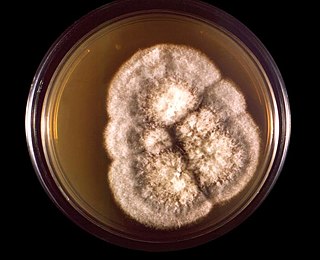
Coccidioides immitis is a pathogenic fungus that resides in the soil in certain parts of the southwestern United States, northern Mexico, and a few other areas in the Western Hemisphere.

Dirofilaria immitis, also known as heartworm or dog heartworm, is a parasitic roundworm that is a type of filarial worm, a small thread-like worm, and which causes dirofilariasis. It is spread from host to host through the bites of mosquitoes. Four genera of mosquitoes transmit dirofilariasis, Aedes, Culex, Anopheles, and Mansonia. The definitive host is the dog, but it can also infect cats, wolves, coyotes, jackals, foxes, ferrets, bears, seals, sea lions and, under rare circumstances, humans.

Arthroconidia are a type of fungal spore typically produced by segmentation of pre-existing fungal hyphae.
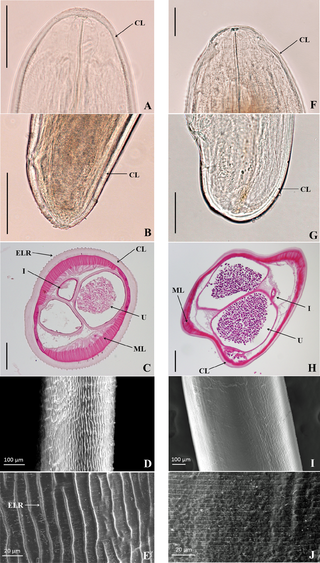
Dirofilariasis is an infection by parasites of the genus Dirofilaria. It is transmitted through a mosquito bite; its main hosts include dogs and wild canids. These can give rise to granulomas in the pulmonary artery. Some common symptoms include cough, fever and pleural effusion. It may also appear on X-rays of the chest.

Coccidioides is a genus of dimorphic ascomycetes in the family Onygenaceae. Member species are the cause of coccidioidomycosis, also known as San Joaquin Valley fever, an infectious fungal disease largely confined to the Western Hemisphere and endemic in the Southwestern United States. The host acquires the disease by respiratory inhalation of spores disseminated in their natural habitat. The causative agents of coccidioidomycosis are Coccidioides immitis and Coccidioides posadasii. Both C. immitis and C. posadasii are indistinguishable during laboratory testing and commonly referred in literature as Coccidioides.

A dimorphic fungus is a fungus that can exist in the form of both mold and yeast. As this is usually brought about by a change in temperature, this fungus type is also described as a thermally dimorphic fungus. An example is Talaromyces marneffei, a human pathogen that grows as a mold at room temperature, and as a yeast at human body temperature.

Coccidioides posadasii is a pathogenic fungus that, along with Coccidioides immitis, is the causative agent of coccidioidomycosis, or valley fever in humans. It resides in the soil in certain parts of the Southwestern United States, northern Mexico, and some other areas in the Americas, but its evolution was connected to its animal hosts.

Primary pulmonary coccidioidomycosis is an infection caused by inhalation of Coccidioides immitis. Once pulmonary symptoms subside, about 30% of women and 15% of men will have allergic skin manifestations in the form of erythema nodosum. A coccidioidoma is a benign localized residual granulomatous lesion or scar that can remain in the lung's tissues following primary pulmonary coccidioidomycosis.

Disseminated coccidioidomycosis is a systemic infection with Coccidioides immitis, in which 15-20% of people develop skin lesions.

Primary cutaneous coccidioidomycosis is a skin condition caused by Coccidioides immitis following a definite history of inoculation or a colonized splinter found in the skin lesion.

Dirofilaria is a filarial (arthropod-borne) nematode (roundworm), in the family Onchocercidae. Some species cause dirofilariasis, a state of parasitic infection, in humans and other animals.
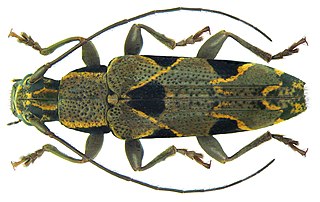
Tmesisternini is a tribe of beetles in the subfamily Lamiinae containing the following genera:
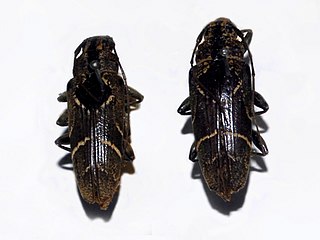
Tmesisternus is a genus of longhorn beetles belonging to the family Cerambycidae, subfamily Lamiinae.

Tmesisternus distinctus is a species of beetle in the family Cerambycidae. It was described by Jean Baptiste Boisduval in 1835.
Tmesisternus dubius is a species of beetle in the family Cerambycidae. It was described by Xavier Montrouzier in 1855.
Tmesisternus postfasciatus is a species of beetle in the family Cerambycidae. It was described by Stephan von Breuning and De Jong in 1941. It is known from Papua New Guinea.
Tmesisternus schaumii is a species of beetle in the family Cerambycidae. It was described by Francis Polkinghorne Pascoe in 1867. It is known from Moluccas, Australia, and the Solomon Islands.

Tmesisternus speciosus is a species of beetle in the family Cerambycidae. It was described by Francis Polkinghorne Pascoe in 1867.
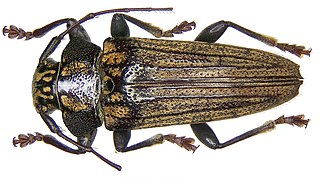
Tmesisternus venatus is a species of beetle in the family Cerambycidae. It was described by James Thomson in 1864.















